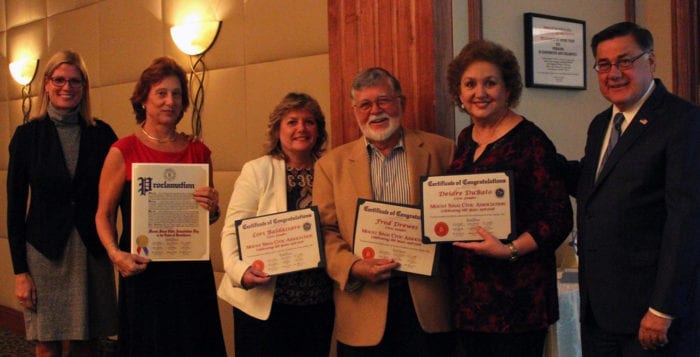If it feels like the morning commute or the ride to the local store is a little smoother, that’s because it is.
Many roads within the Three Village area were repaved over the summer, according to press releases from Brookhaven Town Highway Superintendent Daniel P. Losquadro (R) and Councilwoman Valerie Cartright (D-Port Jefferson Station), who announced the completion of the projects this month.
Two multiroad jobs addressed streets in the vicinity of Minnesauke and Nassakeag elementary schools. In addition, prior to paving, preparations were made for the installation of traffic signals to replace stop signs at the points where Lower Sheep Pasture Road meets Bennetts Road and Pond Path, according to Losquadro.
Traffic Safety Director Jon Sullivan said his office had received multiple complaints from residents, dating back ten years. A traffic study found that over a period of three years, there were a combined 26 traffic accidents at the two locations, he said, warranting the change from stop signs to traffic lights. “The installation will reduce accidents and improve traffic safety,” he concluded.
The estimated cost for the traffic signals is an additional $200,000, according to Losquadro.
In Setauket, around Minnesauke, the highway department resurfaced 11 roads. Andrea Drive, Bennetts Road, Bluetop Road, Captains Walk, Detmer Road, Doolings Path, Hilltop Lane, Michelle Court, Peace Lane, Rising Road and St. George Glen Drive were all freshly paved. The job required several weeks of concrete work, with crews replacing more than 2,700 square feet of aprons and 1,650 linear feet of curb. The total cost for the project was nearly $600,000.
“This paving provided much needed relief for residents and motorists in the vicinity of Andrea Drive and Bennetts Road,” Losquadro said in a statement.
In East Setauket near Nassakeag, 13 streets were paved. Rides on Amherst Court, Cornell Court, Cornwallis Road, Daniel Webster Drive, Hamilton Road, Jackson Drive, Jefferson Court, Montpelier Court, Nathan Hale Drive, University Drive, Washington Avenue, Yale Court and Yorktown Road are much smoother. Crews replaced more than 1,600 square feet of aprons and 1,600 linear feet of curb at a total cost of just over $500,000.
“The two signal builds on Sheep Pasture Road at Bennetts Road and Pond Path are both on hold, awaiting utility relocations,” a spokesman for Losquadro said in an email. “The signal poles are up, but it should be another three weeks before the utility work is finished and we can move forward.”
The lights will be put into a flash pattern for two weeks until residents get acclimated to their presence, and it should be about two months until they’re fully functional, he said.
“Each time we complete a paving project, we improve the quality of life for local residents and there is a positive impact for the larger community,” Cartright said in a statement. “I am glad to announce the completion of this project and we look forward to continuing to work with the Highway Department to make road improvements districtwide.”






















